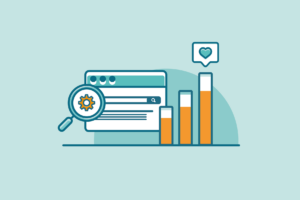
Put simply, the buyer’s journey is the process of research and decision making that leads up to a purchase. But there’s a lot more to it than that...
Here we’ll take a look at what exactly the buyer’s journey is, its different stages, why it’s important and how to create one for your audience. We’ll also look at how to create content that aligns with the buyer’s journey and how this can really benefit your inbound marketing efforts.
Buyer’s journey definition
Let’s start with a clear definition of the buyer’s journey, provided here by HubSpot:
“The buyer's journey is the process buyers go through to become aware of, consider and evaluate, and decide to purchase a new product or service.”
Within the buyer’s journey a business needs to consider not just how people research and purchase, but also the symptoms and problems that form the beginning of their journey, and how they move along the different stages of their journey.
Buyer’s journey stages
The three stages of the buyer’s journey are Awareness, Consideration and Decision.
Awareness
The buyer realises that they have a problem.
They are showing symptoms of a problem and their research at this stage is to understand their problem better in order to define it, rather than looking for a solution to it.
Consideration
The buyer understands their problem and researches ways to solve it.
They have defined their problem and they are now trying to understand the different potential solutions available to them.
Decision
The buyer decides on a solution.
The buyer knows how to solve their problem and researches the products or services to do just that. At this stage they will compare providers and whittle down a list, ultimately making a purchase decision.
Why is the buyer’s journey important?
The buyer’s journey gives value to customers
A major problem with traditional marketing is that it wasn’t designed to help people. Outbound marketing uses tactics that shout for attention and tell people what they need. It doesn’t provide value by educating people, as inbound marketing does.
The buyer’s journey is a vital aspect of this evolved form of marketing because it enables businesses to help their customers, by providing informative content to enable them to understand their problem and their options for solving it.
It will help you sell your products/services
If you can create content that helps your audience at each stage of their buyer’s journey, you will have a good chance of getting them to engage with your website, and subsequently become a lead. You then have the opportunity to nurture that lead with more awesome content and top notch customer service, until they hopefully become a customer. And let’s face it, that’s what we all want, right?
Your ideal customer wants the right content at the right time, which is whenever they need it, and they want it in the format they prefer. By creating content aligned with the buyer’s journey you should always be able to provide them with helpful, relevant content that will be genuinely useful and will aid them in moving along their buyer’s journey.
The proof is in the statistics
Another way to illustrate why the buyer’s journey - and properly aligned content - is important, is with some salient statistics…
- 71% of B2B researchers start with a generic search, rather than looking for a particular brand
- 80% of the buying process will occur without direct human interaction by 2020, according to forrester.com
- 65% of buyers spend more than 16 minutes comparing before making a decision-stage purchase
- 61% of respondents to a DemandGen report chose vendors delivering content appropriate for each stage of the sales process
- 52% of respondents viewed 8 or more pieces of content from the winning vendor
- 86% of senior-level marketers say it’s critical to create a cohesive buyer’s journey
- Leads nurtured with targeted content offer increased sales opportunities of more than 20%
You need to create top quality content aligned with each stage of the buyer’s journey. Your content needs to appear in search engine results for the pertinent keywords your audience will be searching for, in order for them to find it.
This is where keyword research and mapping comes in. This is something Aira’s Dan Brooks wrote about recently, explaining how labelling keywords (found through keyword research) to the stages of the buyer’s journey can help you create content that users and search engines will both like. This way you will appear on search engine results pages, and your audience will be able to find content that helps them, wherever they are on their buyer’s journey.
Keyword research, keyword mapping, content design and creation, content promotion. Putting all this together takes hard work and intelligent strategy, which is often where external consultants from an inbound marketing agency can help. Alternatively you can forge ahead using internal resources. Either way, it can reap rewards if done well.
Buyer’s journey content
OK, so telling you to create great content might be a little obvious, and a little unhelpful. What should your content look like? What format should it take? How exactly should it align to the Awareness, Consideration and Decision phases of the buyer’s journey?
The actual content you create will differ depending on your buyer personas (the semi-fictional projections of your ideal customers), as will the format you choose. Some personas will prefer blog posts, some will prefer video content, some perhaps charts and tables. And the focus of your content will obviously differ too, depending on which of your personas you are targeting.
Let’s briefly look at a couple of Aira’s own buyer personas to explain why content needs to differ:
- Marketing Marvin is a marketing manager and he is interested in traffic growth and lead generation. Marvin gets most of his information from reading industry blogs and news.
- Sally Sales is a sales manager and is much more interested in improving sales processes and customer acquisition. Sally reads industry blogs but also watches a lot of video content.
It’s easy to see that - despite both being potential customers - these two personas would want different content to satisfy their needs and help solve their problems.
It’s essential to develop buyer personas otherwise you won’t be able to create targeted content in an appropriate format, and you won’t be able to map accurate buyer’s journeys for your audience.
With personas you are able to create content that you know will be relevant and useful, and with a buyer’s journey for each persona you can plan content to engage personas at any stage of the buyer’s journey.
How to map content to a buyer’s journey
Now you know a bit about the benefits of the buyer’s journey, maybe it’s worth looking at how to apply it to your inbound strategy. If you want to do buyer’s journey mapping for your own business, here’s how to get started:
Create buyer personas
Yes we’ve already talked about the importance of buyer personas, but having them in place really makes defining your audience’s buyer’s journeys so much easier. If you don’t understand their problems, needs, motivations and goals then how can you create helpful content?
If you’d like to learn more about this stage of the process take a look at our comprehensive guide to buyer personas.
Buyer’s journey examples
Let’s take a look at some buyer’s journey examples to further illustrate the process and show how this can lead to content that is likely to engage your audience.
Here’s a buyer’s journey example for our persona Marketing Marvin. It shows his thought process and the kind of on-site content, and content offer, we might create to attract and engage him:
| Awareness stage | Consideration stage | Decision stage | |
| Thought process | My client’s website traffic has dropped suddenly | I need to increase their website traffic | An SEO audit would help me to develop an effective strategy |
| On-site content | 11 Reasons Why You’ve Seen a Sudden Drop in Website Traffic | 7 Ways to Drive Website Traffic with Limited Time | How Much Should an SEO Audit Cost? |
| Content offer | SEO Traffic Drop Diagnosis (checklist) | The Ultimate Guide to Growing Website Traffic (ebook) | Free 1 hour SEO consultation |
Here’s an example we created for On the Go Tours, who organise group tours and bespoke holidays:
| Awareness stage | Consideration stage | Decision stage | |
| Thought process | I’m too stressed | A holiday will help relieve my stress | Which adventure holiday should I choose? |
| On-site content | 5 ways to prevent stress | The world’s best stress-relieving destinations | The 10 best adventure holidays |
| Content offer | The complete guide on how to deal with stress (eBook) | Hotel or Adventure Breaks? (infographic) | How to choose your perfect holiday (tool/quiz) |
As you can see the process is pretty logical, and it’s not too difficult to plan content to address the problems of your audience, as they move through their buyer’s journey.
Certain types of search terms and phrases often appear as potential buyers reach different stages, which can help you plan the kind of content that would be most helpful, and therefore engaging, for them. As you can see from the image below, awareness stage terms often include things like ‘troubleshoot’, ‘resolve’ and ‘improve’. At the consideration stage you’re likely to see phrases including ‘solution’, ‘service’ and ‘tool’; and at the decision stage terms like ‘compare’ and ‘review’ are common.
Evaluating search terms and their motivations can be helpful when planning content throughout the buyer’s journey, but they are certainly not definitive and should be used as guidelines rather than rules.
Source: HubSpot
Here, very briefly, are your goals for each stage of the buyer’s journey, and content types that might fit the bill:
Awareness
Help the buyer understand and define their problem.
Content: Blog posts, whitepapers and checklists allow you to establish your brand as a reliable source of information.
Consideration
Provide the buyer options for relieving their recently defined problem.
Content: Customer testimonials, product videos and live webinars might help the buyer choose a solution for their issue.
Decision
Persuade the buyer that your company is the best placed to provide them with the solution they’ve chosen.
Content: Free trials, demos and product factsheets might persuade a buyer that you are the brand for them.
But these are just suggestions, which as we’ve said, should change depending on each buyer persona and the product or service you sell.
Just remember that your aim is to create content that is as helpful as possible for your personas at every stage. If you can provide real value to your target audience, your content is likely to bring more traffic to your website and lead to more purchases.
Buyer’s journey templates
Now that you’re familiar with the theory, you might want to try and map content to your own buyer’s journeys for your personas. To give you a bit of a helping hand we’ve created some buyer’s journey templates below that you can download for free, so help yourself!







